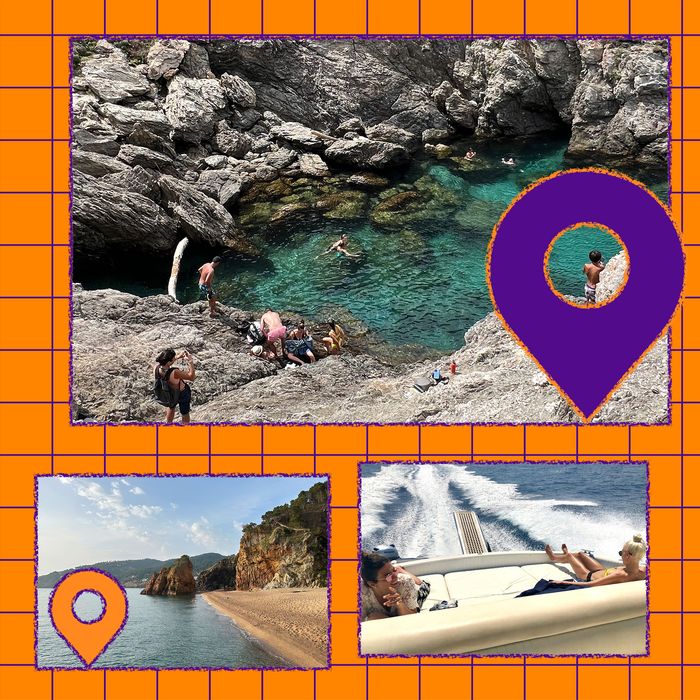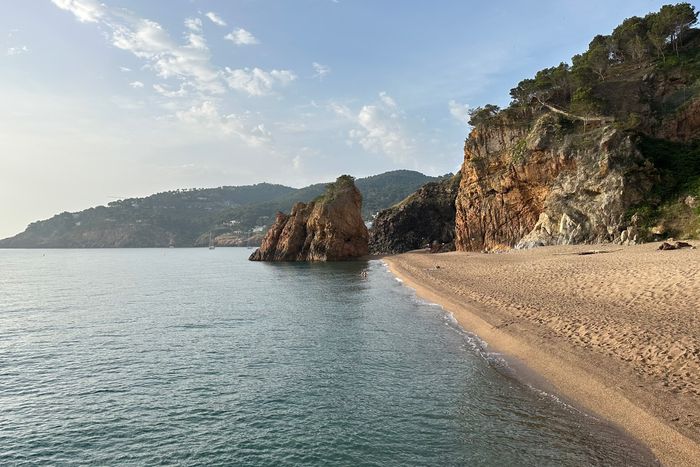
While plenty of beaches on the Mediterranean have been ruined by overcrowding and overexposure, there are little-known, yet still stunning, options with nary a TikToker. People with absurdly good taste gave us the broad strokes (and a few indispensable details) from trips they’ve taken to these very destinations.
The Nantucket of France
Porquerolles, France
“To get to this small island off the coast of the south of France, we drove to Tour Fondue and then took a water taxi. We stayed at Le Mas du Langoustier, a secluded hotel on the far west side of the island. The half-board option at the hotel is like an old-school version of all-inclusive resort in the best way. Breakfast and amazing four-course dinners are included, so it takes a lot of the choice out and you can really embrace just being in nature. The island is filled with hidden beaches and small coves for swimming, and we biked and walked everywhere. One day we hiked the entire island, stopping at various swimming holes, and another day we visited Fondation Carmignac, a contemporary-art museum housed in an old farmhouse. Chanel also happens to own a vineyard on the island called Domaine de L’ile, and we drank a lot of their rosé.” — Caroline McKay, founder of creative agency Caro
Pesce Spada in Calabria
Belvedere Marittimo, Italy
“I like to think I’m living like a real Italian in this tiny beach town in Calabria less than three hours by train from Naples where there are, thrillingly, never that many English-speaking tourists. There are also no luxury hotels — an Airbnb is your best bet. Try to book one that’s near the town center, where you’ll find everything you need: a grocery store, farm stand, pharmacy, and, of course, a wine store and butcher. There are tons of public beaches where you can lie out and paddle in the calm, clear, warm water. The town center has delicious casual restaurants serving pasta, Neapolitan-style pizza, and pesce spada, a.k.a. swordfish, which is a specialty here. At night, there are market stalls selling candy, ceramics, and (randomly) children’s school gear, and there is occasionally live music. You can also walk or take a 20-minute ride on a free shuttle bus up to the centro storico for a sunset aperitivo at Passato e Presente’s garden overlooking the castle ruins, then have Mangalitza pizza at the chic QB Food Lab and Spirits.” — Raquel Medina-Cleghorn, aesthetician and co-founder of Raquel New York
Ancient Abbeys and Butter Boutiques
Northern Brittany, France
“When it’s boiling during the summer in Paris, this is where you want to be: It’s all moody skies, lush green cliffs, granite coastlines, and incredible seafood without the scene. I recommend renting a car and zipping along the coast to take in the stunning views, fishing towns, and wild beaches. In Saint-Malo, you have to stop at the original Le Beurre Bordier shop to stock up on butter — salted, yuzu, seaweed, whatever you can carry — then grab salted caramels from Maison Galland. In Saint-Cast-le-Guildo, you can take e-bikes on the D786 along the coast toward Saint-Lunaire. On the way, stop by Saint-Jacut-de-la-Mer to visit the abbey founded in the fifth century by the monk Saint Jacut. There’s also Plage du Rougeret, a quiet cove with sea views, and Le Théatre, a relaxed little restaurant for golden crêpes. The boardwalk at Saint-Lunaire, with its Belle Époque villas and sea breeze, is a dream. Once back in Saint-Cast, you can go for a freezing swim and collect shells at the public Pen Guen Beach, then head up to the WWII bunkers at Pointe de la Garde in Saint-Briac-sur-Mer. Hidden among the cliffs, the spot offers panoramic views of the English Channel. End the day with galettes and a cold glass of Muscadet at the restaurant Le 19ème, just above the golf course, where you can watch the sun sink behind the harbor. We like to spend a night in Dinard: Stay at Castelbrac if you’re splurging or Hôtel le Printania for its charming sea-view deck. Lunch is crêpes at Petit Bleu, and dinner is oysters at Le Petit Port.” — Sonia Gaillis-Delepine, founder of Verdoie
Lazy Swims on the Costa Brava
Sa Riera, Spain
“This small cove on the Costa Brava is where I go to escape. The sea is always calm, ideal for lazy swims, and the surrounding hills are reassuringly steep, which makes the beach feel private even though it’s public. I like to stay at Finca Victoria, recently reopened after a quiet renovation. Its whitewashed rooms, terra-cotta floors, and unfussy furnishings offer understated serenity. Each evening, I walk the half-hour up to Begur, to Can Climent Platillos, where I eat unusual and wonderful tapas like shrimp carpaccio laced with black garlic or orange-glazed pork sharp with pickled pink ginger.” — Tom Broughton, founder of Cubitts
Young Greek Chefs and Hillside Eco-retreats
“Ithaca, on the Ionian side of Greece, is raw, natural, and totally untouristy. The food is some of the best in Greece — which is a big claim, but I stand by it. The meals are all prepared by young Greek chefs who are reshaping the island’s food scene with creativity. I’m still thinking about the Prespes gigantes beans I ate at Myrtia on our last trip. We stay at Levendis Estate, a small eco-retreat with four villas perched on a hillside. Even the bath products are handmade on site. We spend our days sailing or hiking — there are so many hikes and hidden beaches that you can access only by boat, and it’s essential to do this while you are there.” — Georgia Dant, founder of Marfa Stance
Octopus Meatballs and Abandoned Farmhouses
Lopud, Croatia
“My partner and I have been traveling to Lopud for three consecutive summers, and every time I’m struck by the lushness of the island’s Mediterranean vegetation; the vivid scent of fig, pine, and aromatic herbs carried by the breeze into the harbor; and the beautiful landscape of Renaissance-era stone houses, green hills, and transparent waters. Lopud is a 30-minute water taxi or 45-minute ferry from Dubrovnik and is one of the islands in the Elaphiti Archipelago, between Šipan and Kolocep, two other evergreen islands. Apart from the day-trippers who come to the sandy Šunj Beach, Lopud is relatively quiet, filled with locals and a small community of expats who have restored the stone houses near the old Franciscan monastery — 20 years ago, Baroness Francesca Thyssen-Bornemisza restored it, and now it’s Lopud 1483, a spectacular property that’s available to rent. I always start my days with an hourlong run through the old port, then we have breakfast at home and read and relax for a while before packing sandwiches and heading to one of the nearby coves for a swim. My favorite regular spot is under the monastery, but at least once every trip we head to Šunj Beach for a dip and have lunch at its beachside restaurant. The hike from there back to Lopud’s port is one of my favorite things to do because it takes you up these hills and by abandoned 14th- and 15th-century stone farmhouses and tenth-century early Christian churches with incredible views, towering cypress, Mediterranean pines, and wild thyme, peppermint, and rosemary. If we go out to dinner, there’s Restaurant Dubrovnik, a fish restaurant in the middle of Lopud’s harbor where you have to order a plate of mussels in Buzara tomato sauce, or Konoba Kod Marka on the neighboring island of Šipan, an unpretentious waterside restaurant with the freshest fish and delicious octopus meatballs.” — Carlos Huber, architect, historic preservationist, and founder of Arquiste
High-Season Quiet and Biarritz Adjacency
Guéthary, France
“I’m beholden to my children’s school schedules, so I can’t travel to European beach towns in the offseason the way a lot of people recommend. Guéthary, in Basque Country, is just south of the surfing and dining magnet of Biarritz, and it’s a quiet, beautiful little beach town with an easy atmosphere and great food. We stay in one of the many beach houses rented out by locals. You can grab produce, soaps, chocolates, and gifts at Yaoya, the local Basque and Japanese grocery and deli. In Guéthary, there’s a running trail, and you can also easily hike to the beach just north in Bidart, where there are surfing lessons for children and a beach-shack-style restaurant. We always dine at Le Madrid, or for a more casual meal, there is Hétéroclito on a cliff overlooking the beach or Le Txamara right on the water. At the end of the day, everyone gathers in the town square for ice cream around sunset, and there is often live music outside the main coffee hub and surf club, Parlementia. The coastal local train runs through town, so it’s super-easy to pop up to Biarritz to visit the gallery Champ Lacombe and eat at Cheri Bibi or go south to Saint-Jean-de-Luz and Ciboure for a sailing lesson and lunch at Arraina.” — Anja Tyson, brand consultant
Wildflower Walking Trails
Pembrokeshire, Wales
“The coastline is rugged, but there are sandy inlets where you can swim in the summer months (my favorite beach is at Traeth Llyfn) and beautiful walking paths that are part of the Pembrokeshire Coast Path. It’s a pastoral landscape interspersed with cliff-top vistas and fishing villages. There are so many charming buildings to explore, many of them hundreds of years old. The 12th-century cathedral in St. Davids is an incredible example of medieval architecture from this period, and in most of the tiny seaside towns, you can find remnants of the region’s 19th-century industrial past. Although it’s too cold to swim, Pembrokeshire is also lovely to visit in the spring, when the wildflowers are in bloom and the weather is crisp enough to keep away the crowds. The best places to stay are small owner-operated vacation homes. I loved the Mill House in Nolton Haven; the hosts provided superb guidance on local dining and sightseeing.” — Yannik Neufang, architect and co-founder of Office JDY
Mountainous Montenegro
Dobrota, Montenegro
“The bay water is turquoise and so calm. There are no waves or undercurrents. You can actually swim! Plus you’re tucked in between all these famous Montenegro mountains, so the views are incredible. If you’ve got the time and a taste for adventure, the best way to get there is to rent a car in Italy, then catch the overnight Snav ferry from Ancona to Croatia — you and your car can sleep onboard. Once you wake up on the Adriatic, hit the road down Croatia’s stunning coastline, past Dubrovnik, all the way into Montenegro. We stayed in a cozy Airbnb, of which there are many, but if you’re looking to splurge, there is the Heritage Grand in Perast.” — Olivia Villanti, founder and designer of Chava Studio
Dusty (But Charming) Hotels Near Rome
Pontine Islands, Italy
“There is something very special about the mixture of rocks, salt, sea, and sun here. I fly to Rome, make my way to Anzio and then catch a boat. About one and a half hours later, I arrive on the magical island of Ponza. We either rent a house or stay on a boat or check into a dusty but cute hotel called Chiaia di Luna. The hotel is perched on a cliff, and the beach below (where you’ll spend a lot of time) shares the same name; every day, you will experience the most incredible sunset you’ll ever see in your life and amazing views over the Mediterranean. The terrace of Bar Tripoli is the place to grab a really good coffee, lunch is at Ristoro da Gerardo, and for dinner, go to Aqua Pazza in the port. We spend our days traveling around on a small boat. We always take the boat to Palmarola to eat at my favorite restaurant, O’ Francese, and swim around the rock formations of the Cattedrali di Palmarola. I’ll swim at the Arco Naturale and the Cala Felci cove in Ponza, go diving in Zannone, and head to Ventotene, the most undiscovered gem of all the Pontine Islands.” — David Mallett, hairstylist
Surfing South of Porto
Ericeira, Portugal
“We flew to Porto and then drove down the coast to get to Ericeira. We split our time between an Airbnb and a hotel called You and the Sea right across the street from the beach, which is pristine, empty, and vast with so many places to surf. There’s no bad room at the hotel; because of the sloping streets, everyone gets an ocean view. We spent most of our days driving around searching for the best surfing breaks on Portugal’s west coast, and we ate seafood (the grilled octopus everywhere is amazing), bread, and olives at almost every meal. The town is gorgeous and charming, and the pace is laid-back.” — Joni Brosnan, author, chef, and owner of Joni’s in Montauk
Gallery-Hopping and Bird-Watching
Knokke, Belgium
“Here, you’ll find dozens of art galleries tucked into charming streets, plus plenty of art you’ll happen upon organically: Franz West’s bold lemur heads perch atop cylindrical pillars in Rubensplein, where children zip around on go-karts, and a walk down the beach reveals Antony Gormley’s figure standing sentinel in the water offshore. Even the local casino doubles as an unexpected art destination, housing pieces by Keith Haring and Magritte. Between gallery-hopping, when I visit, I love wandering through Het Zwin nature reserve, where tidal marshes create incredible bird-watching of more than 200 species. I stay at the recently renovated La Réserve, the perfect base for all this exploration, which has an excellent spa.” — Elena Soboleva, strategist and curator
More on Travel
The Strategist is designed to surface useful, expert recommendations for things to buy across the vast e-commerce landscape. Every product is independently selected by our team of editors, whom you can read about here. We update links when possible, but note that deals can expire and all prices are subject to change.





